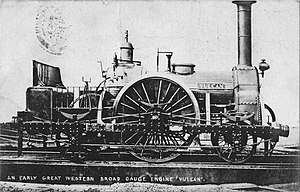GWR Charles Tayleur locomotives
The first 19 locomotives ordered by Isambard Kingdom Brunel for the Great Western Railway included six 2-2-2 Charles Tayleur locomotives. They were built by Charles Tayleur at his Vulcan Foundry but were unsuccessful and rapidly supplemented by the Star Class locomotives ordered by Daniel Gooch once he had been appointed as the Locomotive Engineer. As built, they comprised two groups of three: the first group, delivered in 1837, had cylinders having a bore of 14 inches (360 mm) and the second group, delivered in 1838, had cylinders having a bore of 12 inches (300 mm); all had a stroke of 16 inches (410 mm).
14-inch locomotives
| GWR Vulcan, Æolus and Bacchus | |||||||||||||||||||
|---|---|---|---|---|---|---|---|---|---|---|---|---|---|---|---|---|---|---|---|
 Vulcan after rebuilding | |||||||||||||||||||
| |||||||||||||||||||
| |||||||||||||||||||
| |||||||||||||||||||
- Vulcan (Tayleur 51; 1837–1868)
- This locomotive was the first to run on the Great Western Railway when it was tested on 28 December 1837 from its shed at West Drayton. It was withdrawn in 1843 but was rebuilt as a 2-2-2T tank locomotive and returned to service in 1846, running in this form until 1868. It survived for two more years at Reading as a stationary boiler. It is named after the workshops where it was built, which themselves were named after the Roman god of fire.
- Æolus (Tayleur 52; 1837–1867)
- This locomotive worked the first train on the Great Western Railway when it opened on 4 June 1838. In 1843 it was fitted with more conventional 6-foot-0-inch (1.829 m) driving and 3-foot-0-inch (0.914 m) carrying wheels with 15-by-18-inch (381 mm × 457 mm) cylinders; at some time it was converted to a 2-2-2T tank locomotive.
- Bacchus (Tayleur 53; 1837–1842)
- The name was later carried by a Pyracmon Class goods locomotive.
12-inch locomotives
| GWR Apollo, Neptune and Venus | |||||||||||||||||||
|---|---|---|---|---|---|---|---|---|---|---|---|---|---|---|---|---|---|---|---|
| |||||||||||||||||||
| |||||||||||||||||||
| |||||||||||||||||||
- Apollo (Tayleur 62; 1838–1867)
- This locomotive was rebuilt in 1839 with new cylinders 15 by 18 inches (381 mm × 457 mm) and was altered to become a 2-2-2T before it ceased work in 1867.
- Neptune (Tayleur 63; 1838–1840)
- The name was later carried by one of the Ariadne Class standard goods locomotives.
- Venus (Tayleur 64; 1838–1870)
- This locomotive was withdrawn in 1843 but was rebuilt and returned to service in 1846. It now had 6-foot-0-inch (1.829 m) driving and 3-foot-0-inch (0.914 m) carrying wheels, with 15-by-18-inch (381 mm × 457 mm) cylinders; at some time it was also converted to run as a 2-2-2T tank locomotive. The name was also carried by a Fire Fly Class locomotive from 1841.
gollark: You can, you see, learn things without going through formal education.
gollark: Unlikely. You can probably do some sort of useful stuff.
gollark: Or you could provide a useful thing for osmarks.tk.
gollark: We could just star it. I won't, but we could.
gollark: ^ destroy the moon
References
- Reed, P. J. T. (February 1953). White, D. E. (ed.). The Locomotives of the Great Western Railway, Part 2: Broad Gauge. Kenilworth: RCTS. pp. B9–B10. ISBN 0-901115-32-0.
- Waters, Laurence (1999). The Great Western Broad Gauge. Hersham: Ian Allan Publishing. ISBN 0-7110-2634-3.
This article is issued from Wikipedia. The text is licensed under Creative Commons - Attribution - Sharealike. Additional terms may apply for the media files.